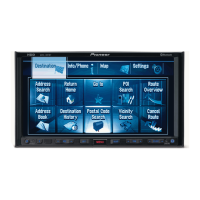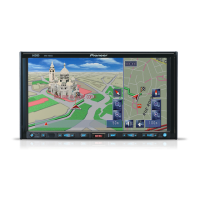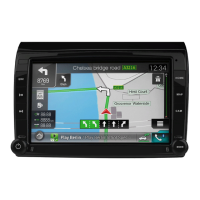Do you have a question about the Pioneer AVIC-HD3 and is the answer not in the manual?
Provides important information for using the navigation system, outlining its basic operation and functions.
Guides users on how to effectively navigate and understand the content of the operation manual.
Details critical safety precautions and warnings to ensure safe operation and prevent hazards.
Provides further safety advice, including details on handbrake interlock and rear view camera usage.
Outlines the sequence of operations from starting the system to turning it off.
Explains how to navigate and interact with the different menus like Destination, Info/Phone, Map, and Settings.
Details the process of searching for a destination by entering its address using the system's interface.
Covers how to review route details, recalculate routes under different conditions, and view route profiles.
Explains how to add, remove, or sort waypoints to customize your route.
Describes how to adjust route calculation priorities like 'Fast', 'Short', 'Main Road', and avoidance options.
Guides users on interpreting the information presented on the map display.
Details the different map display modes like Map Mode, Mixed Mode, and Street List Mode.
Explains various indicators on the map display such as current location, destination, and guidance points.
Describes how to access the map settings menu to customize display options.
Covers selecting whether to display or hide icons, and configuring map display options.
Explains how to choose and customize shortcuts displayed on the map screen for quick access.
Details how to select and display Points of Interest (POI) icons on the map screen.
Provides methods to search for various facilities (Points Of Interest) across the country by name or category.
Explains how to search for nearby Points of Interest (POI) relative to the current location or scroll cursor.
Guides users on how to find a destination by entering its postcode.
Details how to register and calculate routes to home or frequently visited locations.
Explains the benefits of registering locations and the types of registered locations available.
Provides steps to register home and favourite locations for quick route calculation.
Details how to modify the name, pronunciation, phone number, or icon for entries in the Address Book.
Explains how to check real-time traffic information transmitted via the FM Radio Data System (RDS).
Describes how the system automatically suggests or allows manual selection of alternative routes.
Introduces the hands-free phone function, Bluetooth connection, and phone book transfer capabilities.
Details the process of registering a mobile phone and establishing a Bluetooth wireless connection.
Explains how to transfer phone book data from a mobile phone to the navigation system.
Allows separate adjustment of volumes for navigation guidance and phone calls.
Covers changing language, time difference, keyboard layout, and units for navigation functions.
Guides on registering home and favourite locations, and customizing background pictures.
Explains how to reset various system settings back to their default or factory configurations.
Details how to play music CDs, including auto hard disk recording and touch key operations.
Covers playing DVD-Video discs, including source selection, screen configuration, and touch key operations.
Explains how to tune into FM radio stations, store presets, and use features like PTY and TA.
Details operations for the AM radio band, including station selection, tuning, and preset management.
Guides on recording tracks from music CDs to the hard disk, including cautions and procedures.
Explains how to play back and manage recorded tracks, including sorting and playlist creation.
Details how to register favourite tracks into playlists and arrange their playback order.
Covers controlling a connected multi-CD player, including source selection and touch key operations.
Explains iPod control via the navigation system, including browsing songs and managing playback.
Details how to control a connected TV tuner, including channel selection and preset management.
Covers operating the AV input source for video and audio devices.
Explains how to control connected external Pioneer devices via the navigation system.
Details how to connect and operate auxiliary equipment via the AUX input.
Provides an overview of audio visual settings, divided into Audio and System Settings.
Explains how to adjust audio equalization to match vehicle interior acoustic characteristics.
Covers setting parental lock levels to restrict viewing of certain DVD scenes.
Details how to set up and use the rear view camera function for parking assistance.
Guides on adjusting picture settings like brightness, contrast, color, and hue for each source.
Emphasizes safety precautions for voice operation, requiring the vehicle to be stopped.
Explains the system's voice recognition technology and how to use voice commands.
Provides a step-by-step walkthrough of a common voice operation, like searching for a POI.
Lists all available voice commands for navigation and AV operations, categorized by function.
Details four methods to clear user data and reset settings to default or factory configurations.
Provides solutions for common problems encountered with the system's screen and operation.
Lists common system messages, their causes, and recommended actions to resolve issues.
Explains how the system determines vehicle position using GPS, dead reckoning, and map matching.
Provides important information for using the navigation system, outlining its basic operation and functions.
Guides users on how to effectively navigate and understand the content of the operation manual.
Details critical safety precautions and warnings to ensure safe operation and prevent hazards.
Provides further safety advice, including details on handbrake interlock and rear view camera usage.
Outlines the sequence of operations from starting the system to turning it off.
Explains how to navigate and interact with the different menus like Destination, Info/Phone, Map, and Settings.
Details the process of searching for a destination by entering its address using the system's interface.
Covers how to review route details, recalculate routes under different conditions, and view route profiles.
Explains how to add, remove, or sort waypoints to customize your route.
Describes how to adjust route calculation priorities like 'Fast', 'Short', 'Main Road', and avoidance options.
Guides users on interpreting the information presented on the map display.
Details the different map display modes like Map Mode, Mixed Mode, and Street List Mode.
Explains various indicators on the map display such as current location, destination, and guidance points.
Describes how to access the map settings menu to customize display options.
Covers selecting whether to display or hide icons, and configuring map display options.
Explains how to choose and customize shortcuts displayed on the map screen for quick access.
Details how to select and display Points of Interest (POI) icons on the map screen.
Provides methods to search for various facilities (Points Of Interest) across the country by name or category.
Explains how to search for nearby Points of Interest (POI) relative to the current location or scroll cursor.
Guides users on how to find a destination by entering its postcode.
Details how to register and calculate routes to home or frequently visited locations.
Explains the benefits of registering locations and the types of registered locations available.
Provides steps to register home and favourite locations for quick route calculation.
Details how to modify the name, pronunciation, phone number, or icon for entries in the Address Book.
Explains how to check real-time traffic information transmitted via the FM Radio Data System (RDS).
Describes how the system automatically suggests or allows manual selection of alternative routes.
Introduces the hands-free phone function, Bluetooth connection, and phone book transfer capabilities.
Details the process of registering a mobile phone and establishing a Bluetooth wireless connection.
Explains how to transfer phone book data from a mobile phone to the navigation system.
Allows separate adjustment of volumes for navigation guidance and phone calls.
Covers changing language, time difference, keyboard layout, and units for navigation functions.
Guides on registering home and favourite locations, and customizing background pictures.
Explains how to reset various system settings back to their default or factory configurations.
Details how to play music CDs, including auto hard disk recording and touch key operations.
Covers playing DVD-Video discs, including source selection, screen configuration, and touch key operations.
Explains how to tune into FM radio stations, store presets, and use features like PTY and TA.
Details operations for the AM radio band, including station selection, tuning, and preset management.
Guides on recording tracks from music CDs to the hard disk, including cautions and procedures.
Explains how to play back and manage recorded tracks, including sorting and playlist creation.
Details how to register favourite tracks into playlists and arrange their playback order.
Covers controlling a connected multi-CD player, including source selection and touch key operations.
Explains iPod control via the navigation system, including browsing songs and managing playback.
Details how to control a connected TV tuner, including channel selection and preset management.
Covers operating the AV input source for video and audio devices.
Explains how to control connected external Pioneer devices via the navigation system.
Details how to connect and operate auxiliary equipment via the AUX input.
Provides an overview of audio visual settings, divided into Audio and System Settings.
Explains how to adjust audio equalization to match vehicle interior acoustic characteristics.
Covers setting parental lock levels to restrict viewing of certain DVD scenes.
Details how to set up and use the rear view camera function for parking assistance.
Guides on adjusting picture settings like brightness, contrast, color, and hue for each source.
Emphasizes safety precautions for voice operation, requiring the vehicle to be stopped.
Explains the system's voice recognition technology and how to use voice commands.
Provides a step-by-step walkthrough of a common voice operation, like searching for a POI.
Lists all available voice commands for navigation and AV operations, categorized by function.
Details four methods to clear user data and reset settings to default or factory configurations.
Provides solutions for common problems encountered with the system's screen and operation.
Lists common system messages, their causes, and recommended actions to resolve issues.
Explains how the system determines vehicle position using GPS, dead reckoning, and map matching.
| Display Size | 7-inch |
|---|---|
| Resolution | 800 x 480 pixels |
| Touchscreen | Yes |
| Hard Drive Capacity | 30 GB |
| GPS Navigation | Yes |
| DVD Player | Yes |
| CD Player | Yes |
| MP3 Playback | Yes |
| WMA Playback | Yes |
| AAC Playback | Yes |
| Radio Tuner | AM/FM |
| USB Port | No |
| SD Card Slot | Yes |
| Built-in Amplifier | Yes |
| Bluetooth | No |
| Auxiliary Input | Yes |
| Navigation Type | GPS |
| Video Formats Supported | DivX |











